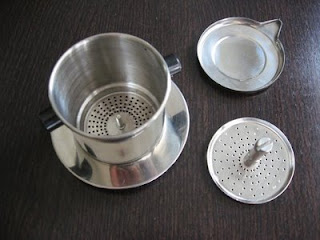

My coffee-aficionado friend has had plenty of ca phe sua da or Vietnamese iced coffee before, but he was particularly intrigued with this old-school method of using a phin or metal coffee filter for ca phe phin, Vietnamese drip coffee. You can find it at restaurants in Little Saigon but they're increasingly switching over to pre-made iced coffees. It's really easy to do it yourself at home, just takes a bit o' patience.
You can buy the phin or metal filter at most Little Saigon supermarkets for under $3.
It comes with three pieces, clockwise, from left to right: The filter, the lid and the press (the flat disc with a metal rod coming out of it).
First, pour some condensed milk into a glass. Pick a clear glass if you're a nerd like me and like watching the coffee action. I usually go with several tablespoons as it helps to cut the super potent and dark roast Vietnamese coffee, but you can always add more later.
You can also pick up a bag of dark roast coffee grounds at most Vietnamese markets, typically at the cash register. My folks go to Vien Dong Supermarket in Garden Grove for their ca phe. About $5 a bag.
Put a kettle of water on to boil. Then, before you put the coffee grounds into the filter, be sure to take out the press. Add a few spoonfuls of coffee grounds into the filter until it's almost halfway full for a strong serving. (Or roughly three teaspoons.) Place the press back into the filter and screw the rod back into place if need be. (Erik did a great job his first time -- betcha thought those large hands were mine, huh?)
Then pour the boiling water into the filter to the top. Cover with the lid and wait about 15 minutes or so.
The coffee will start drip, drip, dripping ... be patient ... after the water goes down, you'll likely want to add one more round of hot water.
Then you just stir up the condensed milk and coffee together and either drink it hot or add ice. And some more condensed milk if need be. Enjoy! your delightful cup of Vietnamese Coffee
Taken from

